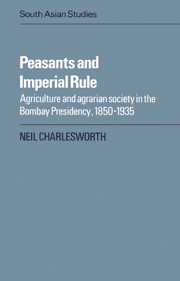Book contents
- Frontmatter
- Contents
- List of maps and tables
- Preface
- Note on technical terms and references
- Maps
- 1 Introduction: the peasant in India and Bombay Presidency
- 2 The village in 1850: land tenure, social structure and revenue policy
- 3 The village in 1850: land and agriculture
- 4 Indebtedness and the Deccan Riots of 1875
- 5 Continuity and change in the rural economy, 1850–1900
- 6 The Bombay peasantry, 1850–1900: social stability or social stratification?
- 7 The agricultural economy, 1900–1935: the critical watershed?
- 8 The impact of government policy, 1880–1935
- 9 The peasant and politics in the early twentieth century
- 10 Conclusions: the problem of differential commercialisation
- Glossary
- Bibliography
- Index
3 - The village in 1850: land and agriculture
Published online by Cambridge University Press: 10 December 2009
- Frontmatter
- Contents
- List of maps and tables
- Preface
- Note on technical terms and references
- Maps
- 1 Introduction: the peasant in India and Bombay Presidency
- 2 The village in 1850: land tenure, social structure and revenue policy
- 3 The village in 1850: land and agriculture
- 4 Indebtedness and the Deccan Riots of 1875
- 5 Continuity and change in the rural economy, 1850–1900
- 6 The Bombay peasantry, 1850–1900: social stability or social stratification?
- 7 The agricultural economy, 1900–1935: the critical watershed?
- 8 The impact of government policy, 1880–1935
- 9 The peasant and politics in the early twentieth century
- 10 Conclusions: the problem of differential commercialisation
- Glossary
- Bibliography
- Index
Summary
The traditional beginning for any examination of agriculture in mid-nineteenth-century India is to emphasise its technical backwardness and the relative absence of stimulants to decisive change. For Bombay Presidency, this might seem particularly appropriate. The province, as we have seen, was predominantly millet-growing and in 1873–4 out of a total of 19.1 million acres under crops in the whole Presidency, the two great staples of jowar and bajra accounted for over 10 million acres. Millets were hardy and adaptable to climatic and ecological variations, but their capacity for high output and rapid yield improvement was limited. They were, for example, incapable of anything like that substantial leap in production sometimes created by the initial expansion of high-yielding rice cultivation – what Braudel calls ‘the miracle of the paddy fields’. At the same time, millet cultivation in South Asia made large demands on land and inhibited diversification into areas like live-stock farming. The physical basis of Bombay agricultural production also seemed to suggest those restrictive features traditionally presented as archetypally ‘Asiatic’. Villages, particularly in the Deccan and the Southern Maratha Country, were large, distinct and, superficially, self-contained. Hence the idea of a primitive, subsistence isolationism gained wide currency among mid-nineteenth-century Bombay officialdom. Each village, one commentator noted, formed ‘a kind of separate republic, with its own peculiar interests, and entirely independent of those around it’. Within it, another wrote, existed an ‘individual equality of poverty’ so that ‘there is wanting that example of prosperity, which is the surest guarantee for inciting emulation’.
- Type
- Chapter
- Information
- Peasants and Imperial RuleAgriculture and Agrarian Society in the Bombay Presidency 1850–1935, pp. 70 - 94Publisher: Cambridge University PressPrint publication year: 1985



